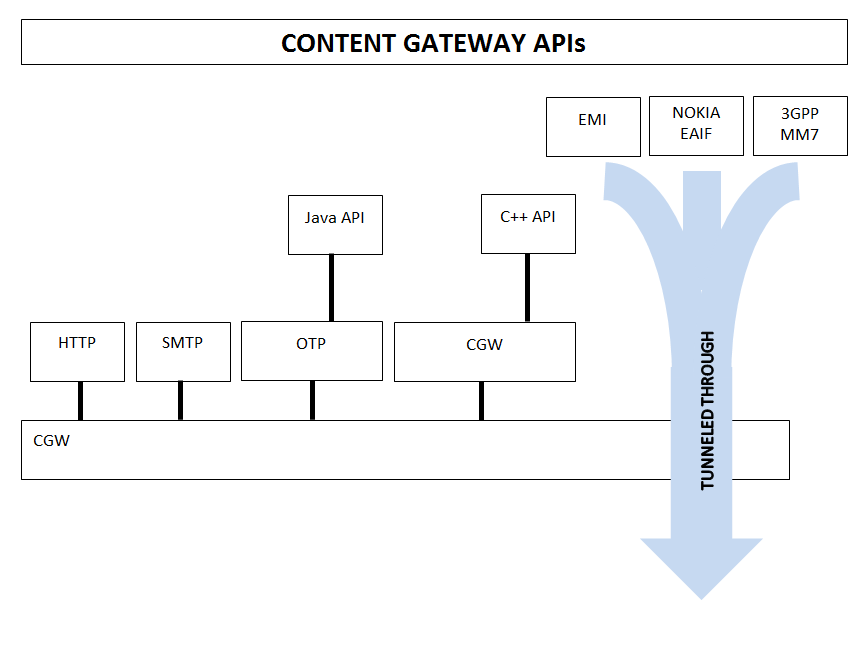This article discusses some of the migration paths from specific Content Gateway APIs towards the single Opaali API. There are dead ends to watch out – for some of the CGW APIs there are no simple migration paths!
send command line utility
While not strictly an API, some users just use the sample applications provided with CGW Provider Server for their message sending needs. The command line send (or send.exe) application is simple to implement as a bash shell script using curl and other command line utilities. (Have a look at send.sh)
HTTP API
Although both CGW and Opaali provide an HTTP API, they look quite different:
- CGW has a simple HTTP GET-request based API
- Opaali has a modern REST API (both GET and POST) with OAuth2 based authentication
Another difference is where in the network topology the API is located:
- in the customer’s network (Provider Server of CGW)
- in the operator’s network (Opaali API)
The good news is, that it is relatively easy to implement most of the CGW HTTP API on top of Opaali API, and you can place this implementation where your CGW Provider Server is located (so you might not need to make any changes at all to your current applications).
You can implement this in e.g. Java (in fact there are already several internal partial implementations using this technique) or you could use a scripting language (like node.js) for maximum portability.
While sending an MT message using an HTTP-request in CGW was easy (a simple URL containing all the parameters) receiving MO messages was just as simple (a HTTP GET callback with predefined parameter substitutions) and getting Delivery Reports was not much harder (the actual status was in custom HTTP headers though).
Opaali API uses an HTTP POST request with parameters in a JSON body for most operations, and you need to maintain an authenticated session for client initiated requests. You can configure callback notifications to be used for MO messages and MT delivery Reports, but you will either need to adapt to the new request format or implement translation to the CGW style in your “Provider Server emulator”…which might not be worth the trouble.
Those were the easy ones…
Unfortunately migration paths from the other old CGW APIs are not so straightforward. As HTTP is universally used in modern applications, Opaali has no need for programming language specific APIs like the C++ or Java libraries provided with CGW. Notice also, that CGW’s Provider Server was a native (non-portable) implementation and only available for Windows or Linux in recent times. In contrast, you can use Opaali-API from any platform supporting HTTP (and that practically means any platform today).
Java and C++ libraries
The Java and C++ libraries are documented in detail in CGW documentation so based on that (and C++ header file/Java library bytecode) you should be able to implement the same API on top of Opaali API. As it would be easier to just rewrite your application to use HTTP this makes sense only if you cannot change your application (like when you don’t have access to the original source code, that is).
As the Java library is implemented on top of OTP protocol and C++ library on top of CGW internal (undocumented) protocol you could continue using the existing libraries if you can get an implementation of those on top of Opaali API, but that is even less likely to happen.
OTP
The OTP protocol is actually documented in CGW documentation so it should be possible to make your own implementation (and get the Java library support as a bonus!).
UCP/EMI
UCP/EMI is a low level SMSC API, access to which CGW can provide through a tunnel, as CGW uses UCP/EMI underneath. Opaali uses a different SMSC API, so UCP/EMI is not available. Telia wishes to move away from providing low level SMSC specific APIs so they will not be available to Opaali users. Instead, Telia plans to provide some extensions to the standard OMA REST Messaging API so that the most common low level SMSC API use cases can be implemented (this is still work in progress so no details are available now). As UCP/EMI specification is publicly available, it would be possible to implement a UCP/EMI to Opaali API gateway, but you would need to have a really good reason for spending your resourses this way (why not rewrite your application instead - could be easier?)
SMTP
CGW has a built-in SMTP server for implementing a Mail-to-SMS (and back) Gateway. For Opaali you would need to find a third party implementation. The security requirements for SMTP servers today are much higher than they were when CGW was introduced - many networks don’t allow your own server at port 25 anymore.
MMS
I am not covering MMS here. Opaali does support MMS but not necessary the same API that was used in CGW (for which finding documentation might be a bit challenging these days). MMS support will come in a future release of Opaali.
Then there is also MOBILE CHARGER…
Mobile Charger is another topic which will probably deserve its own article.
 JPLa is a member of the Content Gateway (CGW) to Opaali migration team, specialising in programming related issues and API usage.
JPLa is a member of the Content Gateway (CGW) to Opaali migration team, specialising in programming related issues and API usage.